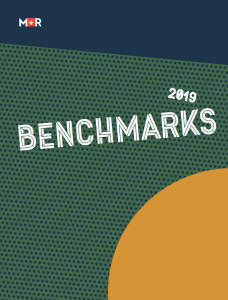When this email landed in my inbox recently, I almost cried…
“Does anyone else ever feel like they’re always behind and never, ever, ever going to catch up? Do you ever feel like you’re the ONLY person in your department or organization who knows what’s going on and people are constantly coming to you for things to the point that you can’t get your own priorities done? My inbox is overflowing, my to-do list is miles long, and sometimes it all feels so overwhelming that I could just give up and cry!”
If this feels like you, I hear you.
Your world is crazy busy. Distractions abound. You’re spending HOURS on Facebook, with nothing to show for it. And now your fundraising board chair wants you to be on Instagram too.
You’re about to crack.
Relax. Help is on the way.
 The M+R Benchmarking data report is out and it’s…interesting.
The M+R Benchmarking data report is out and it’s…interesting.
First off, surprisingly online giving was close to flat, only up 1%. Email lists grew (by 5%) and nonprofits are sending more email. But revenue from email is down.
But – get this – while “overall online revenue may have been flat year-over-year, revenue from recurring monthly gifts increased by 17%.” And it gets better. “Monthly giving accounted for 16% of all online revenue in 2018, up from 13% in 2017.”
How can the small shop fundraiser navigate the world of digital strategically? Without spinning their wheels?
First of all, I’m going to tell you that our Basics & More students and subscribers who are achieving the greatest success have not put all their eggs in the digital fundraising basket. Our biggest achievers embrace a multi-channel approach, one that is centered on direct mail (yes, good old direct mail) complemented by digital.
Here’s where they’re focused on:
Email newsletters
The research shows us that if you’re looking to raise real money with your donor newsletter, print is the way to go. But a well-done email newsletter plays no small role in keeping your supporters engaged — and in attracting new subscribers.
How to do it:
1. Keep it consistent. Whether your enews will go out weekly, bi-weekly, or monthly, make a schedule and stick to it. Not sure what you can possibly report on every week? It doesn’t have to be a full newsletter. Get some inspiration from this example from Save the Chimps.
2. Send your enewsletter only to those who have opted in.
3. Don’t forget to welcome your new subscribers with an *inspire and delight* Welcome email. Remember: “Welcome emails generate four times the total open rates and five times the click rates compared to other bulk promotions.” Doesn’t it make sense to offer your prospective donor a warm welcome, one that thanks them and lets them know what to expect? Try testing an email welcome series. Start to gain a greater understanding of your supporters by incorporating a one-question survey.
4. Don’t stress over design. The only one loving those fancy graphics is you. Don’t believe me? Email me for real-world tests. Keep your enewsletter simple and easy-to-read for older eyes.
5. Do stress over subject lines. After all, you want to get your enewsletter opened, don’t you? Pay attention to the subject lines that compel you to open (rather than hit *delete*). Check out the Emotional Marketing Value Headline Analyzer. It’s not foolproof, but it’s a great tool.
6. Keep it simple. The Hemingway App will aid in streamlining your enewsletter copy. Get in the habit of using it for everything you put out. Aim for a writing level of 5th grade and under.
Do you have a monthly giving program?
Remember, I’m talking about a named monthly giving program — not an afterthought check-off box on your donate form. Retention rates for online fundraising are in the toilet. Only “37% of donors who made a gift online in 2017 donated online again to that nonprofit in 2018.”
Monthly giving is your BFF. Retention rates run at 90% and up. Include at least one dedicated monthly giving campaign a year. Consider a monthly giving ask to just those in your email list. Perhaps test a monthly giving *upsell* lightbox on your site (see last year’s Motivate Monday session to learn more).
According to M+R, Facebook fundraisers are booming. How are you letting your best supporters know they can make an even bigger impact by starting one? Check out Sean Kosofsky’s succinct training, Everything You Need to Know to Raise Thousands of Dollars With a Facebook Fundraiser, on how to maximize yours and get the most donor information possible.
What else?
M+R reports that “in 2018, users on mobile devices accounted for 48% of all traffic to nonprofit websites, compared to just 44% for desktop.” A web designer friend of mine STARTS all design on mobile. It’s not enough that your site is optimized for mobile. Make sure your donate page is as well. I’ve only just started mystery shopping via mobile, and even the biggest nonprofits are failing this test.
We’ll have more on the M+R report in a future post. For now, know that your strategy for digital should complement your overall fundraising strategy. And if you’re running ragged, thinking that you’ve got to be on every social media platform out there posting countless times a day, check out the April 22nd episode of Motivate Monday. That’s where International fundraiser Denisa Casement shares what’s really working in digital today (beyond the hype).

















 I can’t wait to meet with you personally.
I can’t wait to meet with you personally.
Comments on this entry are closed.